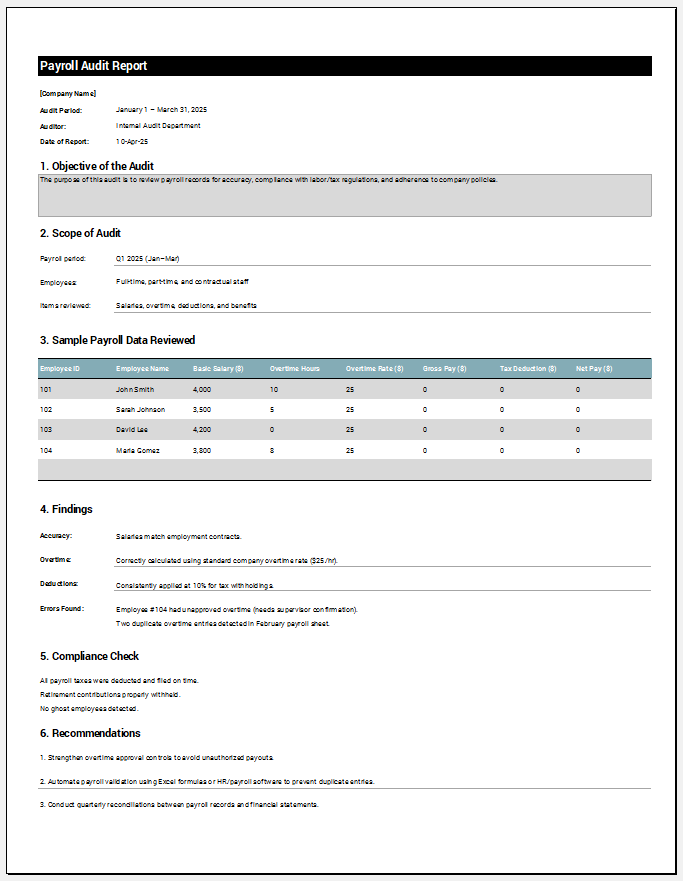Companies usually have a payroll audit that is a review of the company’s payroll records as well as processes. This ensures there is accuracy present and that the company is complying with all regulations in place. It also makes sure employees are paid properly. To analyze the findings and make them understandable, a payroll audit report can help.
This document summarizes the findings of the payroll audit. This reviews the company’s payroll procedures and records and presents the findings in this report. It lets the employer or boss know if there are any errors.
The report makes sure all employees are paid accurately. It lets one know whether the company is complying with labor laws and internal policies. The report identifies any mistakes when it comes to payroll-connected data. The company can be saved from legal issues if it follows all payroll procedures in place.
The report includes an executive summary that highlights the key findings, including any errors or compliance issues. The objectives of the audit are outlined. The audit procedure employed to analyze data is present. The report includes the findings, analysis, and recommendations.
Advantages and limitations of the report
The following are some advantages of a payroll Audit Report:
- Ensures employees are paid accurately and on time.
- Identifies and corrects payroll errors, helping the company avoid legal issues.
- Confirms the company’s compliance with labor laws and internal policies.
- Promotes a positive work environment by ensuring fair compensation and transparent payroll processes.
Some limitations of a payroll audit report include:
- The preparation and compilation process can be lengthy, as it requires careful attention to numerous details.
- Any human error during data entry or analysis may reduce the validity and reliability of the findings.
(MS Excel Template)

File: MS Excel (.xlsx)
How to make a Payroll Audit Report?
A payroll audit report must be prepared with attention to ensure it is both accurate and relevant. The following points outline the essential components to include when drafting this report.
Professional format: The report should follow a clear and professional layout. Begin with the heading “Payroll Audit Report”, and include the company’s name along with the specific audit period.
Executive Summary: This section highlights the key findings of the audit, such as discrepancies, compliance issues, and overall assessment of the payroll system.
Objectives: Here, outline the specific processes reviewed during the audit, such as salary calculations, overtime payments, tax deductions, and benefits compliance.
Audit procedures: This section explains the specific audit procedures and techniques used to gather and analyze payroll data.
Analysis: Add this section to detail any errors, inconsistencies, or irregularities identified during the audit.
Recommendations: This section provides targeted actions to correct identified errors and strengthen payroll processes.
Conclusion: The conclusion summarizes the overall health of the company’s payroll system, highlighting whether it meets required standards and regulations.
The tips
The following tips can be useful when making this report:
Application: Drafting the report in a suitable application provides a formal and professional format that enhances credibility.
Relevant details: Draft the report into sections and include only essential information. This approach helps you make a clear, professional, and easy report.
So finally…
A company that wants to ensure all employees are getting paid right must conduct a payroll audit. The results of this will need to be presented professionally to the concerned authorities. This is where a payroll audit report comes in. When made right, it ensures the company knows if there are any issues in payroll and how to fix these. The report can be analyzed so that any issues can be fixed before they turn into major legal problems.
- Contractor Entry Log Template
- Holiday Party Planner Template
- Marketing Forms Used by Businesses
- HR-related Form Templates
- Personal Finance Tracker
- Daily Dog Care Checklist
- Holiday Shopping Budget Sheet
- Volunteer Work Hour Schedule Worksheet
- Vehicle Booking Sheet Template
- Payroll Audit Report Template
- Bonus Payment Record Sheet
- Overtime Payment Sheet Template
- Meeting Minute Examples
- Vacation Packing Checklist
- Carry-On Essentials List Template